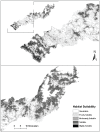Habitat suitability models of mountain ungulates: identifying potential areas for conservation
- PMID: 31966124
- PMCID: PMC6661442
- DOI: 10.1186/s40555-015-0116-9
Habitat suitability models of mountain ungulates: identifying potential areas for conservation
Abstract
Background: Determining the distribution of species and of suitable habitats is a fundamental part of conservation planning. We used slope and ruggedness of the terrain, forest type and distance to the nearest village to construct habitat suitability maps for three mountain ungulates (barking deer (Muntiacus muntjak), Himalayan goral (Naemorhedus goral) and Himalayan serow (Capricornis thar)) inthe midhills of western Nepal. We used locations of sightings and signs of presence of these mountain ungulates collected during surveys along transect to derive a suitability value for each variable using Jacob's index. A multiplication approach was used to combine environmental variables andproduce a habitat suitability map for each of the three species. An independent dataset was used to evaluate the maps using Boyce's index. This approach provides an overview of the probable distributions of the species in question.
Results: We predict that of the total area studied, 57% is suitable for M. muntjak, 67% for N. goral and 41% for C. thar. Although there are suitable habitats for all three species throughout the study area, the availability of high-quality habitats for these species varied considerably.
Conclusions: Suitable habitats for N. goral and C. thar were fragmented and mostly confined to the southern and northern parts of the study area. This study provides important baseline information for conservation biologists concerned with maintaining biodiversity in the midhills of Nepal.
Keywords: Capricornis thar; Habitat model; Midhills; Muntiacus muntjak; Naemorhedus goral; Nepal.
Figures





References
-
- Abbitt Rjf, Scott J M, Wilcove D S. The geography of vulnerability: incorporating species geography and human development patterns into conservation planning. Biol Conserv. 96:169–175.
-
- Andrén H. Effects of habitat fragmentation on birds and mammals in landscapes with different proportions of suitable habitat: a review. Oikos. 71:355–366.
-
- Austin M P, Meyers Ja ; 03753-X, Berry W D, Feldman S ;, Beverly Hills Boitani L, Sinibaldi I, Corsi F, Biase A D, Carranza I, Ravagli M, Reggiani G, Rondinini C, Trapanese P. Current approaches to modelling the environmental niche of eucalypts: implication for management of forest biodiversity. SAGE Publications, Inc. 85:605–621.
-
- Bonn A, Gaston K J. Capturing biodiversity: selecting priority areas for conservation using different criteria. Biodivers Conserv. 14:1083–1100.
-
- Boyce M S, Vernier P R, Nielsen S E, Schmiegelow Fka. Evaluating resource selection functions. Ecol Model. 157:281–300.
LinkOut - more resources
Full Text Sources
Other Literature Sources
